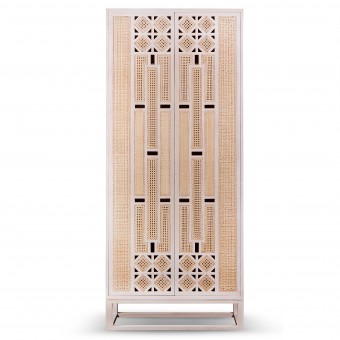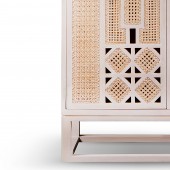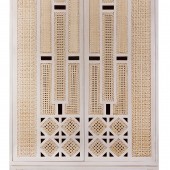Basilisa Armoire by Ito Kish |
Home > Winners > #29548 |
 |
|
||||
| DESIGN DETAILS | |||||
| DESIGN NAME: Basilisa PRIMARY FUNCTION: Armoire INSPIRATION: When I was young I remembered how my grandmother Basilisa can easily repair a dining chair with Solihiya weave. I watched her amazed at how she can create the pattern. The wooden lattice patterns, used in old houses back in my home town was the inspiration to farem the solihiya. I also realized that this weaving is very Filipino and part of our culture which must be appreciated by everyone. UNIQUE PROPERTIES / PROJECT DESCRIPTION: The Basilisa shows the solihiya using rattan - an intricate weave used and as an addition to its aesthetic drama. Each weave showcases a different pattern, but unites through the exquisite play of light, pattern and shadow. It is this chiaroscuro which makes the Basilisa a Filipino beauty to behold. The Solihiya patterns which shows the exquisiteness of our culture, and shapes that give a new modern look. I used 5 types of weaves familiar in different parts of The Philippines. OPERATION / FLOW / INTERACTION: - PROJECT DURATION AND LOCATION: Conceptualization started March 2012. Prototyping began in October 2012 and it was exhibited in Manila FAME March 2013. FITS BEST INTO CATEGORY: Furniture Design |
PRODUCTION / REALIZATION TECHNOLOGY: All the materials used in the Basilisa armoire have been sourced from sustainable materials and means of production: Kiln dried Mahogany is a fast growing hardwood, and both Mahogany and the rattan are farmed and sourced locally in the Philippines. Weaving was done by artisans in small neighborhoods giving them livelihood. SPECIFICATIONS / TECHNICAL PROPERTIES: 901.7 mm x 609.6 mm x 1905 mm TAGS: Lounge, rattan, weaving, cane, lattice, mahogany, Filipino, Asian RESEARCH ABSTRACT: The weave patterns were very important. We looked at different patterns even at fabrics that were familiar to some tribes and even baskets that can be found in the Philippines. CHALLENGE: Identifying the weaves that can work together and making sure we find someone who can do the solihiya or weaves was a challenge. The solihiya is part of our everyday life. The lattice was also researched because we wanted to use something that is part of our culture and history and we found the pattern in old demolished colonial houses. ADDED DATE: 2013-06-28 01:32:33 TEAM MEMBERS (1) : Aikay Tablac IMAGE CREDITS: Ito Kish, 2013. |
||||
| Visit the following page to learn more: http://www.kish.ph | |||||
| AWARD DETAILS | |
 |
Basilisa Armoire by Ito Kish is Winner in Furniture Design Category, 2013 - 2014.· Press Members: Login or Register to request an exclusive interview with Ito Kish. · Click here to register inorder to view the profile and other works by Ito Kish. |
| SOCIAL |
| + Add to Likes / Favorites | Send to My Email | Comment | Testimonials | View Press-Release | Press Kit |







